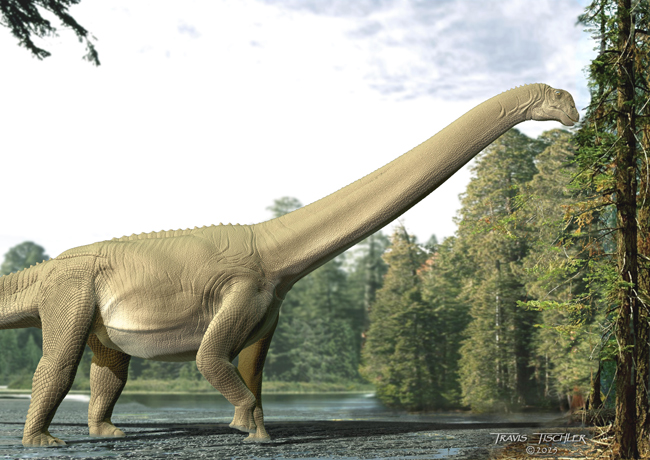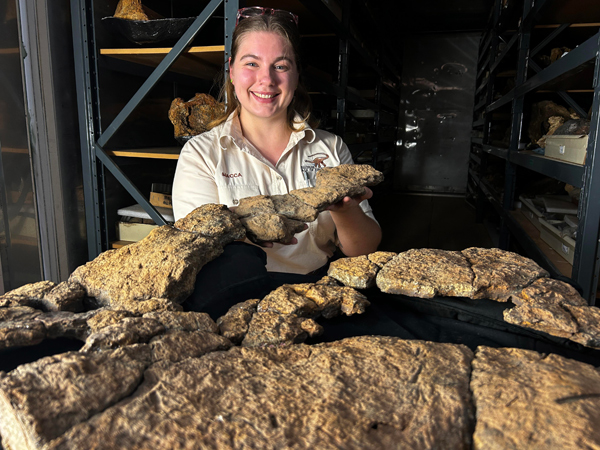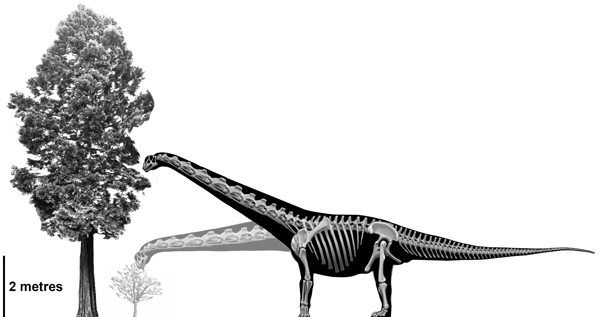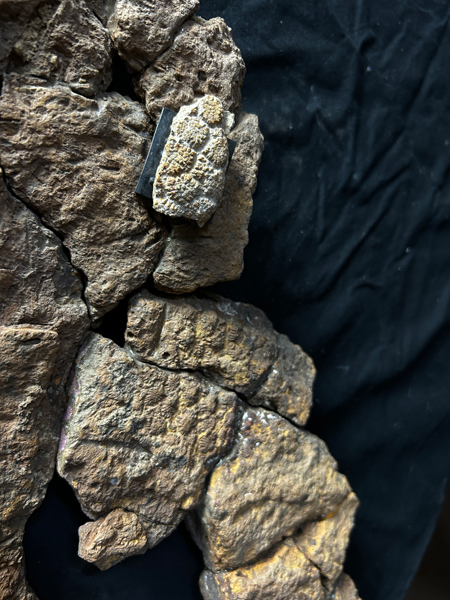Scientists have revealed the last meal of an Australian herbivorous dinosaur that lived ninety-five million years ago. Researchers writing in the journal “Current Biology” report on the discovery of Diamantinasaurus matildae stomach contents. This remarkable discovery is the first time that sauropod stomach contents have been identified. The analysis of the plant remains suggests bulk feeding and multi-level browsing. The Diamantinasaurus nicknamed “Judy” was not fussy when it came to food. Plants eaten by Diamantinasaurus include conifers, seed ferns and angiosperms. In addition to the fossilised stomach contents, the scientists also examined mineralised skin found with the specimen. This revealed a pattern of polygonal (often hexagonal) non-overlapping scales, a characteristic commonly seen in other sauropods.

A life reconstruction of the Australian titanosaur Diamantinasaurus matildae. Picture credit: Travis Tischler.
Picture credit: Travis Tischler
Diamantinasaurus matildae Stomach Contents
Sauropods were abundant and diverse throughout the Jurassic and Cretaceous. The Sauropoda include the largest terrestrial animals known to science. Studies of teeth suggest these dinosaurs were herbivorous. However, our knowledge of their diet is based on indirect evidence such as coprolites (dung). Furthermore, no fossilised gut contents (cololites) were known. Intriguingly, this all changes with the publication of a remarkable study that describes Diamantinasaurus matildae stomach contents.

Subadult Diamantinasaurus matildae stomach contents. Undigested leaves can be clearly observed in the cololite. Picture credit: Australian Age of Dinosaurs.
Picture credit: Australian Age of Dinosaurs
The fossil material was collected from Winton Formation exposures (Queensland, Australia). The cololite was located in the abdominal region and closely associated with a layer of mineralised skin. Detailed analysis of the cololite reveals the plant material eaten. Conifer pinnules, angiosperm leaves, and seed-fern fruiting bodies are preserved. In addition, chemical biomarkers are identified consistent with angiosperms and gymnosperms.
This Diamantinasaurus matildae cololite provides the first direct, empirical evidence in sauropods of herbivory, demonstrating generalist feeding, low- to high-level browsing, and minimal oral processing of food. It seems that these animals were not fussy what plant material they consumed. They did not chew or grind up their food, relying on their enormous guts to digest the plant material. Food may have persisted in their guts for a fortnight or more before being excreted.

Australian Age of Dinosaurs Collection Manager Mackenzie Enchelmaier (co-author of the study) highlighting the Diamantinasaurus gut contents. Picture credit: Australian Age of Dinosaurs.
Picture credit: Australian Age of Dinosaurs
The study marks the first use of molecular techniques to identify sauropod stomach contents.
Sauropods Feeding at a Range of Heights
The research was led by Dr Stephen Poropat (Curtin University, Perth, Western Australia). The Diamantinasaurus specimen, originally found in 2017 has provided unprecedented detail on the feeding habits and diets of the Sauropoda.

The first direct, empirical evidence in sauropods of herbivory, demonstrating generalist feeding, low- to high-level browsing, and minimal oral processing of food. Picture credit: Australian Age of Dinosaurs.
Picture credit: Australian Age of Dinosaurs
To read Everything Dinosaur’s blog post from 2009 about the discovery of Diamantinasaurus: A Trio of New Dinosaurs from Australia.
Dr Poropat stated:
“The specific plants that they ate, and the height above ground at which they fed, have remained unknown – until now. The stomach contents we found belonged to a 12-metre-long, subadult sauropod that was still growing at the time of its death. Our findings show that at least some species of subadult sauropods were able to feed at a range of heights above ground level, and consequently were equipped to deal with environmental and vegetation changes throughout the Jurassic and Cretaceous periods.”
Co-author of the study, John Curtin Distinguished Professor Kliti Grice added:
“By using advanced organic geochemical techniques, we were able to confirm the presence of both angiosperms and gymnosperms in the diet of this sauropod. This unique approach provided molecular evidence of the plants that sauropods consumed.”
Mineralised Skin
Furthermore, this amazing titanosaur fossil specimen revealed details of its skin texture. The researchers identified a pattern of five-sided (often hexagonal), non-overlapping scales. This type of integumentary covering has been found in other sauropod specimens. The scales measure between seven and thirteen mm in diameter. Each scale is covered in small bumps (papillae). Their appearance is consistent with other known sauropod skin fossils.

Mineralised skin found with the Diamantinasaurus specimen known as Judy reveals polygonal (often hexagonal) scales. Picture credit: Australian Age of Dinosaurs.
Picture credit: Australian Age of Dinosaurs
The Diamantinasaurus matildae stomach contents and mineralised skin were preserved alongside yet-to-be-published body fossils of the subadult. The fossils are housed at the Australian Age of Dinosaurs Museum. These fossils will form a key part of the Australia Through Time exhibition in the Museum’s future multi-million-dollar facility.
The longevity of the clade Sauropoda was underpinned by the persistence through time of generalist feeders like Diamantinasaurus matildae that were capable of feeding at a range of heights on a wide variety of different plant species.
Everything Dinosaur acknowledges the assistance of a media release from the Australian Age of Dinosaurs in the compilation of this article.
The scientific paper: “Fossilized gut contents elucidate the feeding habits of sauropod dinosaurs” by Stephen F. Poropat, Anne-Marie P. Tosolini, Samantha L. Beeston, Mackenzie J. Enchelmaier, Adele H. Pentland, Philip D. Mannion, Paul Upchurch, Karen Chin, Vera A. Korasidis, Phil R. Bell, Nathan J. Enriquez, Alex I. Holman, Luke M. Brosnan, Amy L. Elson, Madison Tripp, Alan G. Scarlett, Belinda Gode, Robert H. C. Madden, William D. A. Rickard, Joseph J. Bevitt, Travis R. Tischler, Tayla L. M. Croxford, Trish Sloan, David A. Elliott and Kliti Grice published in Current Biology.
For models and replicas of dinosaurs and other prehistoric animals: Dinosaur Models.




Leave A Comment